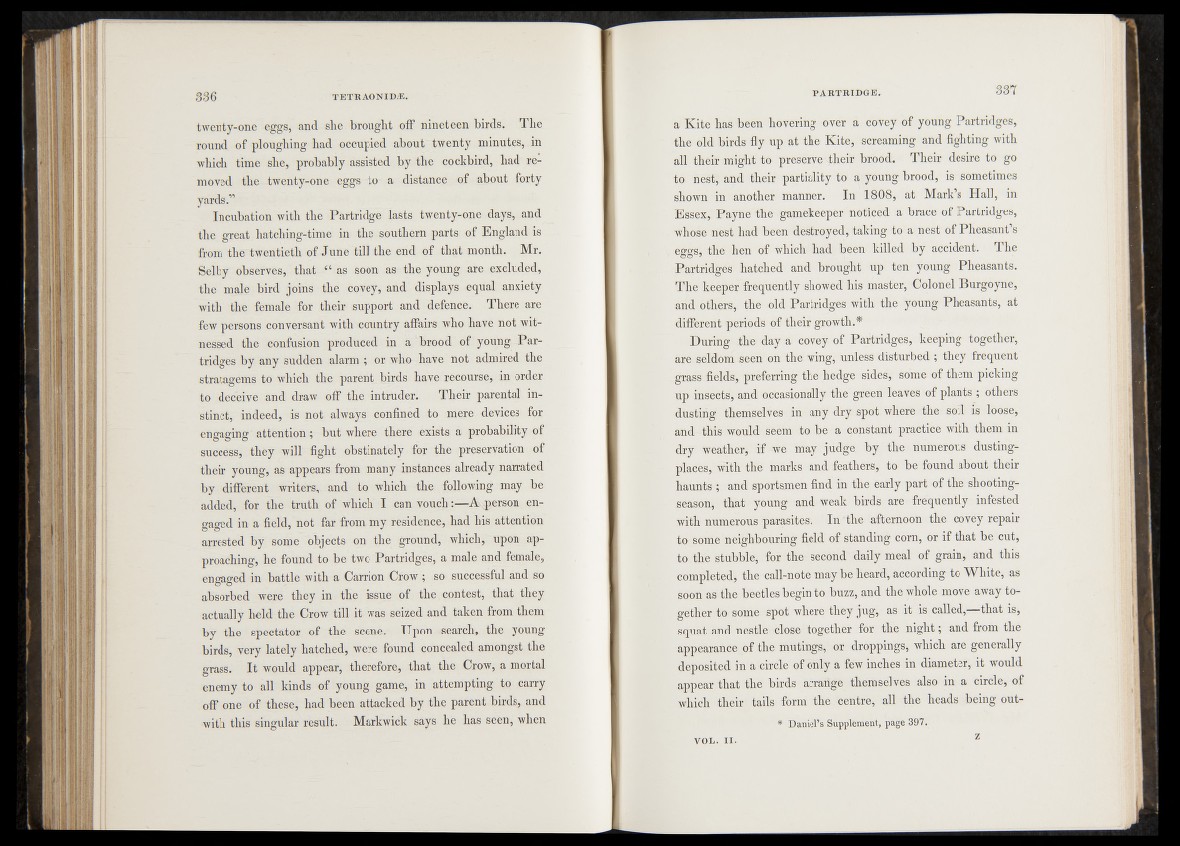
twenty-one eggs, and she brought off nineteen birds. The
round of ploughing had occupied about' twenty minutes, in
which time she, probably assisted by the cockbird, had removed
the twenty-one eggs to a distance of about forty
yards.”
Incubation with the Partridge lasts twenty-one days, and
the great hatching-time in the southern parts of Englandjis
from the twenticth of June till the end of that month. Mr.
Selby Observes, that “ as soon as the young are excluded,
the male bird joins the covey, and displays equal anxiety
with the female for their-support and defences There are
few persons conversant with country affairs who have not. witnessed
the confusion produced in a "brood of' young. Pa rtridges
by any sudden alarm ; or who have not admired the
stratagems to which the parent, birds have recourse, in order
to deceive and draw off the intruder. Their parental instinct,
indeed, is not always confined-to meTe devices, for
engaging - attention ; but where there exists a probability of
success, they will* fight obstinately for the preservation >of
their young, as appears from many instances already narrated
by different writers,-and to which the. ^following "may be
added, for the truth of which I can v o u ch ^A ^ e rso n , engaged
in afiel'd/not far from mResidence, had his-attention
arrested by some objects on the ground, which, upon approaching,
he found to be two Partridges, a male and female,
ensured in battle with a Carrion O O x Crow ; so successful and so
absorbed were they in tEe issue of the^ciptegt, ;that they
actually held-,the Crow till it was seized and taken from them
by the spectator of the scene. Upon ^search, the young
birds, very lately hatched, were found concealed amongst the
grass. It would appear, therefore, that the Crow, a mortal
enemy to all kinds of young game, in attempting to carry
off one of these, had been attacked by the parent birds, and
with this singular result. Markwick says he has seen, when
a Kite basbefefl hovering >over a ;ebvey of young Partridges,
the- old birds fly up at the Kite, screaming and fighting with
' al*l their mightHo preservexfheir brood. Their desire to go
td nest;' and their partiality to a. young brood, is sometimes
M own in another manner. In 180% at Mark’s Hall, in
Esses, Payne the gamekeeper noticed a brace of Partridges,
Whose nest had been destroyed, taking to a nest of Pheasant’s
ews; the hen of which had been killed by accident. The
Partridge’s hatched and brought up’ tfln-young Pheasants.
The keeper^frequently showed his master, Colonel Burgoyne,
and &thSrSj the old Partridges with1 the young Pheasants, at
different periods of thdtf growth.*
During ;$tfe day a co'vey'of Partridges, keeping together,
are seldom seen on the wing, unless'disturbed^; they frequent
-grass' fields, preferring the hedgfl^sides^sflme of them picking
up insects, and occasionally the green leaves of plants; others
dusting themselves’ in* an^ dry spot where •■■'the* Soil is "'loose,
§§i|d-4his would seein to be a qopstant prfetice with them in
dry weather,5Sf-we may; julge*i% 'the numerous dusting-
places, with the- marks and feathers, to be found about their
haunts-'; and -Sportsmen find in--'the- early p&rtof the shooting*-
season* that young and weak birds are frequently infested
with .numerous parasites; In 'the afternoon #thb covey repair
to some neighbouring field ofsstanding corn, or if that be cut,
to/fffe jtetubble,1 for the-sec^hd^jdaily meal of grain, and All
completed; the call-note maybe heard, according to White, as
soon as- theb'eetles begin to buzz; and the whole move away together
to some spot where they jug, as it is called;?* that is,y
squat and-heS^fe ck>se4 together for the night; and from A i
appearance j) f the mu tings, or droppings, which are generally
deposited in a circle of only a few inches in diameter , it would
appear that the birds arrafige themselves also in a circle, of
which their’ tails form' the centre, all the heads being out-
* Dafliefs Supplement, page 397.
VOL. I I. Z